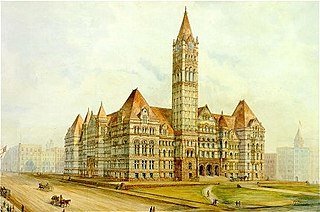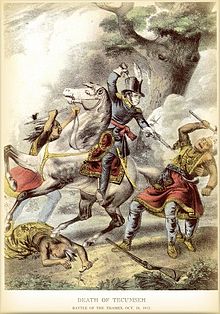
The Province of Upper Canada was a part of British Canada established in 1791 by the Kingdom of Great Britain, to govern the central third of the lands in British North America, formerly part of the Province of Quebec since 1763. Upper Canada included all of modern-day Southern Ontario and all those areas of Northern Ontario in the Pays d'en Haut which had formed part of New France, essentially the watersheds of the Ottawa River or Lakes Huron and Superior, excluding any lands within the watershed of Hudson Bay. The "upper" prefix in the name reflects its geographic position along the Great Lakes, mostly above the headwaters of the Saint Lawrence River, contrasted with Lower Canada to the northeast.

The Wyandot people are Indigenous peoples of the Northeastern Woodlands of North America, and speakers of an Iroquoian language, Wyandot.

Thayendanegea or Joseph Brant was a Mohawk military and political leader, based in present-day New York and, later, Brantford, in what is today Ontario, who was closely associated with Great Britain during and after the American Revolution. Perhaps the best known Native American of his generation, he met many of the most significant American and British people of the age, including both United States President George Washington and King George III of Great Britain.

The Beaver Wars, also known as the Iroquois Wars or the French and Iroquois Wars were a series of conflicts fought intermittently during the 17th century in North America throughout the Saint Lawrence River valley in Canada and the Great Lakes region which pitted the Iroquois against the Hurons, northern Algonquians and their French allies. As a result of this conflict, the Iroquois destroyed several confederacies and tribes through warfare: the Hurons or Wendat, Erie, Neutral, Wenro, Petun, Susquehannock, Mohican and northern Algonquins whom they defeated and dispersed, some fleeing to neighbouring peoples and others assimilated, routed, or killed.

The Province of Quebec was a colony in British North America which comprised the former French colony of Canada. It was established by the Kingdom of Great Britain in 1763, following the conquest of New France by British forces during the Seven Years' War. As part of the Treaty of Paris, France gave up its claim to the colony; it instead negotiated to keep the small profitable island of Guadeloupe.

The Grand River, formerly known as the River Ouse, is a large river in Ontario, Canada. It lies along the western fringe of the Greater Golden Horseshoe region of Ontario which overlaps the eastern portion of southwestern Ontario, sometimes referred to as Midwestern Ontario, along the length of this river. From its source near Wareham, Ontario, it flows south through Grand Valley, Fergus, Elora, Waterloo, Kitchener, Cambridge, Paris, Brantford, Ohsweken, Six Nations of the Grand River, Caledonia, and Cayuga before emptying into the north shore of Lake Erie south of Dunnville at Port Maitland. One of the scenic and spectacular features of the river is the falls and Gorge at Elora.

Southern Ontario is a primary region of the Canadian province of Ontario. It is the most densely populated and southernmost region in Canada, with approximately 13.5 million people, approximately 36% of Canada's population of 37 million. The region lies south of the province's other primary region, Northern Ontario, although the exact northern boundary of Southern Ontario is disputed. However, its core region is situated south of Algonquin Park, the latter being in an area of transition between coniferous forest north of the French and Mattawa Rivers and southern deciduous forest. It covers between 14 and 15% of the province, depending on the inclusion of the Parry Sound and Muskoka districts which also lie in the transitional area between northern and southern forest regions. Southern Ontario differs greatly from Northern Ontario, having a much higher population density, a different climate, and a different culture than its northern counterpart. It is broken into smaller subregions, including Central Ontario, Eastern Ontario, the Golden Horseshoe, and Southwestern Ontario.

Six Nations is demographically the largest First Nations reserve in Canada. As of the end of 2017, it has a total of 27,276 members, 12,848 of whom live on the reserve. These nations are the Mohawk, Cayuga, Onondaga, Oneida, Seneca and Tuscarora. Some Lenape live in the territory as well.

The Neutral Confederacy was a tribal confederation of Iroquoian peoples. Its heartland was in the floodplain of the Grand River in what is now Ontario, Canada. At its height, its wider territory extended toward the shores of lakes Erie, Huron, and Ontario, as well as the Niagara River in the east. To the northeast were the neighbouring territories of Huronia and the Petun Country, which were inhabited by other Iroquoian confederacies from which the term Neutrals Attawandaron was derived. The five-nation Iroquois Confederacy was across Lake Ontario to the southeast.

The colony of Canada was a French colony within the larger territory of New France. It was claimed by France in 1535 during the second voyage of Jacques Cartier, in the name of the French king, Francis I. The colony remained a French territory until 1763, when it became a British colony known as the Province of Quebec.

The history of Ontario covers the period from the arrival of Paleo-Indians thousands of years ago to the present day. The lands that make up present-day Ontario, the most populous province of Canada as of the early 21st century have been inhabited for millennia by groups of Aboriginal people, with French and British exploration and colonization commencing in the 17th century. Before the arrival of Europeans, the region was inhabited both by Algonquian and Iroquoian tribes.

Brigadier-General Sir John Johnson, 2nd Baronet was an American-born military officer, magistrate, landowner in the British Indian Department who fought as a Loyalist during the American Revolutionary War. He was the son of Sir William Johnson, 1st Baronet, who was the first British Superintendent of Indian Affairs. He inherited his father's baronetcy and estate in 1774.

Nottawasaga Bay is a sub-bay within Georgian Bay in Southern Ontario, Canada located at the southernmost end of the main bay. The communities located on Nottawasaga Bay are Meaford, The Blue Mountains, Collingwood, Wasaga Beach and Tiny.

The Toronto Purchase was the sale of lands in the Toronto area from the Mississaugas of New Credit to the British crown. An initial, disputed, agreement was made in 1787, in exchange for various items. The agreement was revisited in 1805, intended to clarify the area purchased. The agreement remained in dispute for over 200 years until 2010, when a settlement for the land was made between the Government of Canada and the Mississaugas for the land and other lands in the area.

By the arrangements of the Canadian federation, Canada's monarchy operates in Ontario as the core of the province's Westminster-style parliamentary democracy. As such, the Crown within Ontario's jurisdiction may be referred to as the Crown in Right of Ontario, His Majesty in Right of Ontario, the King in Right of Ontario, or His Majesty the King in Right of Ontario. The Constitution Act, 1867, leaves many functions in Ontario specifically assigned to the sovereign's viceroy, the lieutenant governor of Ontario, whose direct participation in governance is limited by the constitutional conventions of constitutional monarchy.

The Haldimand Proclamation was a decree that granted land to the Mohawk who had served on the British side during the American Revolution. The decree was issued by the Governor of the Province of Quebec, Frederick Haldimand, on October 25, 1784, three days after the Treaty of Fort Stanwix was signed between others of the Six Nations and the American government. The granted land had to be purchased from the Mississaugas of the Credit whose traditional territory spans much of modern-day Southwestern Ontario. On May 22, 1784, Col. John Butler was sent to negotiate the sale of approximately 3,000,000 acres of land located between Lakes Huron, Ontario, and Erie for £1180.00 from the Mississaugas of the Credit. Of the land ceded, some 550,000 acres were granted to the Mohawk nation in the Haldimand Proclamation. The sale by the Mississaugas of the Credit is also referred to as the "Between the Lakes Treaty."

The Petun, also known as the Tobacco people or Tionontati ,(Dionnontate, Etionontate, Etionnontateronnon, Tuinontatek, Dionondadie,or Khionotaterrhonon), were an indigenous Iroquoian people of the woodlands of eastern North America. Their last known traditional homeland was south of Lake Huron's Georgian Bay, in what is today's Canadian province of Ontario
The Draper Site is a precontact period Huron-Wendat ancestral village located on a tributary of West Duffins Creek in present-day Pickering, Ontario, approximately 35 kilometres northeast of Toronto. The site is found in a wooded area on existing farmland and may be reached by walking from the end of North Road.

During the American Revolution, those who continued to support King George III of Great Britain came to be known as Loyalists. Loyalists are to be contrasted with Patriots, who supported the Revolution. Historians have estimated that during the American Revolution, between 15 and 20 percent of the white population of the colonies, or about 500,000 people, were Loyalists. As the war concluded with Great Britain defeated by the Americans and the French, the most active Loyalists were no longer welcome in the United States, and sought to move elsewhere in the British Empire. The large majority of the Loyalists remained in the United States, however, and enjoyed full citizenship there.

Huronia is a historical region in the province of Ontario, Canada. It is positioned between lakes Erie, Ontario, and Huron. Similarly to the latter, it takes its name from the Wendat or Huron, an Iroquoian-speaking people, who lived there from prehistoric times until 1649 during the Beaver Wars when they were defeated and displaced by the Five Nations of the Iroquois who lived in New York.



















